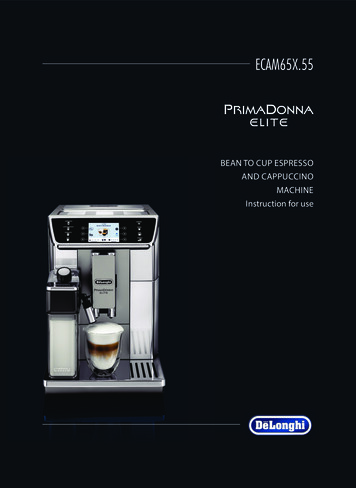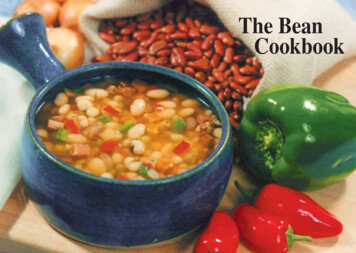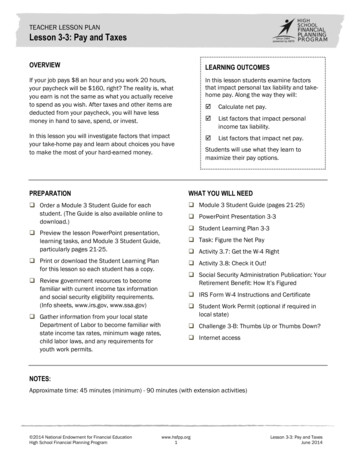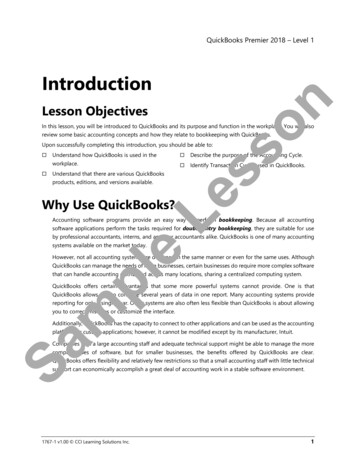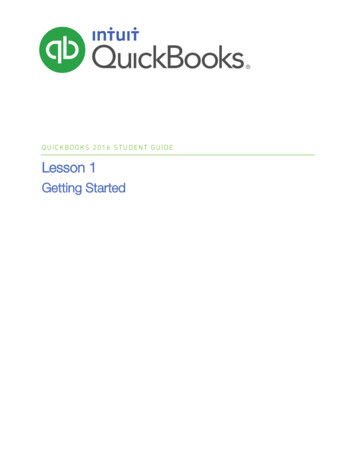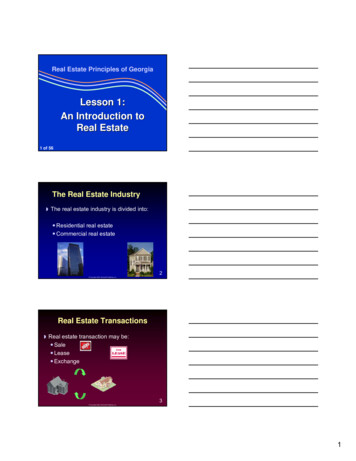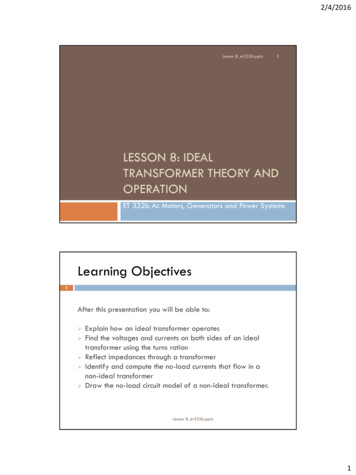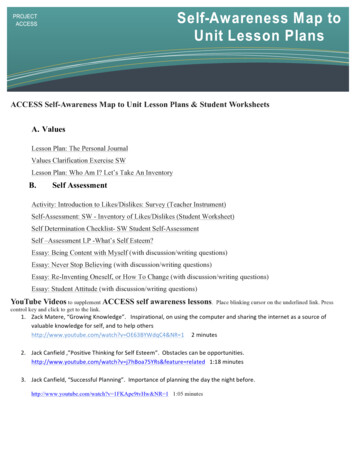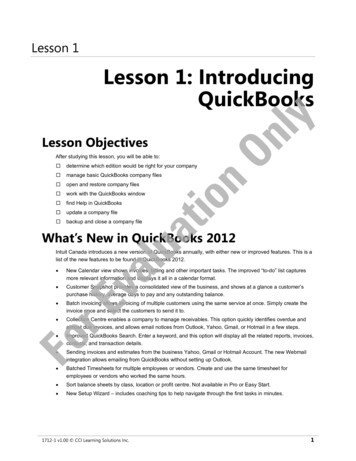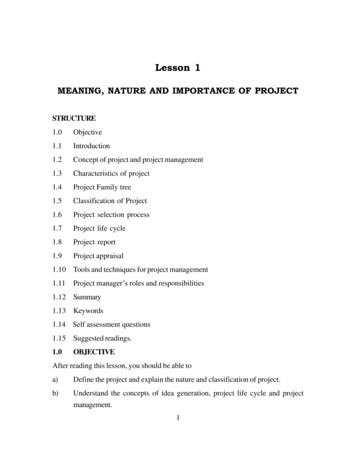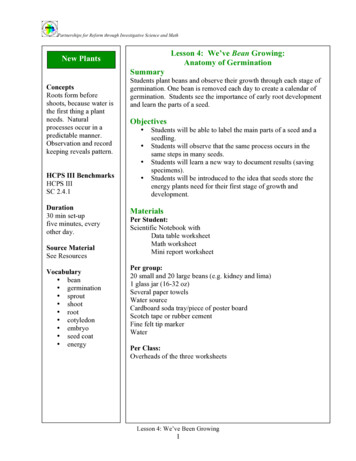
Transcription
Partnerships for Reform through Investigative Science and MathLesson 4: We’ve Bean Growing:Anatomy of GerminationNew PlantsSummaryConceptsRoots form beforeshoots, because water isthe first thing a plantneeds. Naturalprocesses occur in apredictable manner.Observation and recordkeeping reveals pattern.Students plant beans and observe their growth through each stage ofgermination. One bean is removed each day to create a calendar ofgermination. Students see the importance of early root developmentand learn the parts of a seed.Objectives HCPS III BenchmarksHCPS IIISC 2.4.1Duration30 min set-upfive minutes, everyother day.Source MaterialSee ResourcesVocabulary bean germination sprout shoot root cotyledon embryo seed coat energy Students will be able to label the main parts of a seed and aseedling.Students will observe that the same process occurs in thesame steps in many seeds.Students will learn a new way to document results (savingspecimens).Students will be introduced to the idea that seeds store theenergy plants need for their first stage of growth anddevelopment.MaterialsPer Student:Scientific Notebook withData table worksheetMath worksheetMini report worksheetPer group:20 small and 20 large beans (e.g. kidney and lima)1 glass jar (16-32 oz)Several paper towelsWater sourceCardboard soda tray/piece of poster boardScotch tape or rubber cementFine felt tip markerWaterPer Class:Overheads of the three worksheetsLesson 4: We’ve Been Growing1
Partnerships for Reform through Investigative Science and MathMaking ConnectionsMost of your students will be able to recognize a bean. Beans are seeds! Why are theyso much larger than the other seeds we have planted so far? Why do we eat bean seeds but notbrassica seeds for dinner?The answer is energy! We think of beans as a healthy source of protein. They are“filling,” meaning we access their energy slowly, and the energy in them sticks with us throughthe day. The energy in a single bean is also enough to power a seed through root and shootdevelopment, and the unfolding of its first large, broad leaves. Each plant makes lots of beanseeds, because lots of animals agree that they are a great source of food!Teacher Prep for Activity1. COLLECT JARS or ask students to bring them in.2. PURCHASE 2 DIFFERENT KINDS OF BEANS, SMALL and LARGE. 15 bean soup mixusually works, too. Attempt to sprout the beans at home, to be sure they are viable. Wet afolded paper towel. Line up several beans, and lightly twist the paper towel. Stand it up in aglass jar. The beans should germinate within a few days. If not, you can try soaking themovernight, with a pinch of citric acid or squeeze of lemon juice in the water, before transferringto the paper towel. Or buy fresher dried beans or bean seeds from another source. Keep yourhome jar going so you know what your timeline will be like.3. FIND CARDBOARD SODA TRAYS OR POSTER BOARD, one per group. Most stores arehappy to give away soda trays (the cardboard box that holds four six-packs of soda).4. COPY THE THREE WORKSHEETS found at the end of this lesson: One for each student,stapled into their scientific notebook.5. COPY THE THREE WORKSHEETS ONTO OVERHEAD PROJECTOR FILM. You willuse these to demonstrate how to fill in the worksheets.Lesson 4: We’ve Been Growing2
Partnerships for Reform through Investigative Science and MathBackgroundThe most important nutrient for initiating germination in virtually all seeds is water. The firstindicator that germination is under way is usually the emergence of the root. The root isspecialized for taking up water to continue nourishing the young sprout, so it is important for itto be established first. As the plant continues to grow and develop, the shoot (stem and leaves)starts to push upward. The starch or fat in the cotyledon supplies the embryo with the energyand building blocks for growth during the first phase of the plant’s life. If all goes well, theinfant plant will soon form leaves, develop the pigment chlorophyll, and begin producing its ownfood through s/wgbh/tdc02/tdc02 img insideseed/tdc02 img insideseed.jpgBecause we are animals and cannot produce our own food, we rely on plants to produce food forus. One way we supply ourselves with food is to eat seeds. In the process we derive nutritionfrom the embryo of the plant. Mostly we benefit from the food stored in the cotyledon, whichwould have nurtured the developing plant right after germination and before photosynthesis.When we eat grains, we are eating the starchy food supply of the corn, wheat, rice, or oat seed.When we eat nuts, we are eating the fatty storage supply intended for the walnut, almond, orpeanut embryo. Beans are known as protein sources and when we eat them we are eating theprotein supply meant to drive hardy roots down to water and broad leaves to the sunlight theemerging bean plant needs. Our bodies break down protein slower than sugar or fats, which iswhy beans seem so filling—the energy stays with us for hours. All that protein takes up space,which explains why bean seeds are so much larger than brassica seeds. Storing lots of energy ina seed is one strategy to make sure a new plant is able to compete with other seedlings whereverit is sown (smaller-seeded plants often demonstrate an alternate strategy: making lots moresmall, energetically cheap, seeds).Most seedlings send out their root first, followed then by their shoot. Cotyledons emerge andopen, followed by the first true leaves. The seed case sometimes falls off the top of the openingcotyledon, or is left underground. These are predictable steps in the natural process ofgermination: a pattern of nature that helps us to understand that all plants are related.Lesson 4: We’ve Been Growing3
Partnerships for Reform through Investigative Science and MathVocabulary:bean: small round kidney-shaped or round seed that is eaten as a vegetable and can be dried topreserve.germination: the sprouting of a seedling from a seed.sprout: the upward growth of a new seedling; a stem, with its cotyledon(s) attached.shoot: same as sprout.root: an underground plant part that absorbs water and nutrients from the soil.cotyledon: also called seed leaf; the first leaf or pair of leaves produced by a germinatingseedling.embryo: an undeveloped plant contained within a seed.seed coat: the tough, weather-resistant outer covering of a seed.energy: the ability or power to do workProcedure1. INTRODUCE BEANSa. Call the students to the rug.b. Discuss how the brassica plants are growing.c. Show the students some beans and discuss things you might be able to do with them. [eatthem, plant them, feed them to pigs]2. DISCUSS GERMINATIONa. Usually, no one can see exactly what happens when a seed sprouts, because the seeds areunder the ground.b. Explain that you can see how seeds sprout if you plant these beans in paper towels in aglass jar. They are bigger than brassica, so it will be easier to see what happens.c. Ask what else the students think will be different about the bean plants, compared to thebrassica, or grass, plants. [seeds are bigger, so plants might be bigger, grow faster]3. DEMONTRATE THE PLANTING PROCEDUREa. This is a much simpler activity than the others, so you might have the students sit in theirgroups and prepare the seed jars all together.b. Pass out beans and wet paper towels. Have the students line their beans up in the centerand twist.Lesson 4: We’ve Been Growing4
Partnerships for Reform through Investigative Science and Mathc. Point out that there is one seed of each size for each student. Ask students to predict:Which seed will sprout first? Why? Which seedling will be biggest? Why? Which onewill get leaves first?4. MAKE JOURNAL ENTRIESAsk students to carefully sketch one bean (any kind), with as much detail as they are able.5. EXPLAIN DAILY RECORDINGTell students that they will be selecting the seeds from the jar and observing them everyday or two, and recording their observations in their journal calendar.6. MAKE WORD BANK ENTRIESbeanenergyshootsproutBREAKPOINTDAILY OBSERVATION1. OBSERVE SEEDSa. Each day, ask students to check whether there is any sign of life in their jars.b. On the day the first beans begin to split or sprout, call students to the rug.c. Have students sit in groups and pull out the paper towel to examine any sprouting beans.d. EXAMINE ALL BEANS: Do all the sprouts come from the same place in the bean?This place is called the embryo: it was attached to the small indentation you can see onbeans before planting.e. EXAMINE UNSPROUTED BEANS: Have students remove one unsprouted bean ineach size and carefully peel off the seed coat. The seed coat is just like a coat we wear it protects the seed from the weather until conditions are right for germination.f. Students should then be able to peel the two halves of the bean apart to see what’s inside.Students should be able to make out the endosperm “food storage,” embryo “keiki,”cotyledons or embryonic leaves “leaves,” and radicle, or embryonic root “root.”g. Tape or glue the opened seed and its coat in the top corner of the cardboard box (wherethe first calendar day would be if it were a calendar). This is a control, to compare withthe other sprouting seeds, and remind students that the parts were all there, tucked intothe seed, from the start.h. OBSERVE AND RECORD SPROUTED BEANS: Have students choose another seedthat has sprouted. TAPE onto the box, next to the opened control seed.i. Using the felt tip marker, one student should label the emerging parts by writing anddrawing arrows directly onto the box. The others in the group will take turns each day.The first day, you should only see roots. Instead of the date, write the number of dayssince “planting” the beans (i.e. Day 4) under each specimen.2. CONTINUE SPECIMEN COLLECTIONLesson 4: We’ve Been Growing5
Partnerships for Reform through Investigative Science and Matha. Each day or two, repeat this process, pulling out a small and a large bean, and tapingthem to the collection.b. Label new parts as they emerge (students take turns).c. Call students’ attention to whether the small and large seeds are going through the samesteps, at the same time, and whether the seedlings look similar or different. Students candiscuss this in their groups and share with the class.3. REPORT FINDINGSWhen all seeds are collected or both types of seeds have produced seedlings with openleaves, the experiment is done.a. Students should write up a report that describes what they observed, and how the twotypes of seeds compared.b. Students should use proper vocabulary words, include specific observations, and describethe elapsed time period.c. Students should propose a hypothesis (guess) about why the two kinds of seeds behavedsimilarly or differently, or some other interesting observation, and explain one way theymight test their idea. [ The seedlings came out of all seeds on the same day. I thinkthis is because they are all beans, even if the two kinds look different. I could tryplanting lots of different kinds of beans and see if they all sprout in 6 days. Then I wouldknow that is just how beans are].d. If this report is a new type of activity for the class, a worksheet with starting-off phrasesfor each section of the report is helpful. One example is included at end of lesson.e. If there is time, students may give oral reports on their findings.4. GOING FURTHEROne outcome of this activity might be some questions about how the beans could growwithout soil. Discuss this with your students, and encourage them to come up with moreexperiments to find out what it was that caused the bean to sprout. Was it light? Water? Apaper towel? The glass jar? Of course, the answer is water but can they come up with a goodway to prove it?AssessmentsAssessment of the specimens collection should note whether students labeled the plant parts anddays correctly, and worked well together a group. Report grade should reflect whether studentsaccurately reported real observations, made use of new vocabulary, and proposed a reasonablehypothesis and test (excellent), did well in a few of these areas (fair) or needs assistance toimprove in recording, vocabulary, and reasoning.ResourcesFOSS New Plants ProgramLyn Imamura, Waikoloa Elementary, demonstrated this activity.Google “parts of a seed” for images and webpages: Encyclopedia Britannica has a nice beangermination diagram.Lesson 4: We’ve Been Growing6
Partnerships for Reform through Investigative Science and MathSprouting Bean Book: This printable booklet has diagrams and appropriate vocabulary, andmight be well worth the 20 annual fee to join Enchanted /plants/books/sproutingbean/Enchanted Learning also has a printable worksheet for labeling parts of a bean seedling and theanswers!Teacher’s Domain provides a good description of the parts of seed and the roles of From Seed to Plant: An Educator's Reference Desk Lesson Plan. A whirlwind of plant cience/Agriculture/AGR0010.htmlEtc.Extension ActivitiesBean Maze: Divide a large shoebox or t-shirt box into 9-12 cubicles, using extra pieces ofcardboard. Poke a hole through two sides of each “cubicle” to make a maze. Fill one cornercubicle with moist soil, and plant a bean seed. Seal the box with duct tape, leaving just onequarter sized hole for light at the end of the maze. The bean will travel through the box,following the light. If the dividers in the box are not fairly flush, the bean may find a way to“cheat” its way through! Check on the bean after a week, or whenever it emerges. How did itknow which way to go? [plants are able to sense and respond to light. It’s one way we knowthey are alive] Where did it get the energy for the journey? [energy from the sun, packaged in t
Anatomy of Germination Summary Students plant beans and observe their growth through each stage of germination. One bean is removed each day to create a calendar of germination. Students see the importance of early root development and learn the parts of a seed. Objectives Students will be able to label the main parts of a seed and a seedling. Students will observe that the same .
